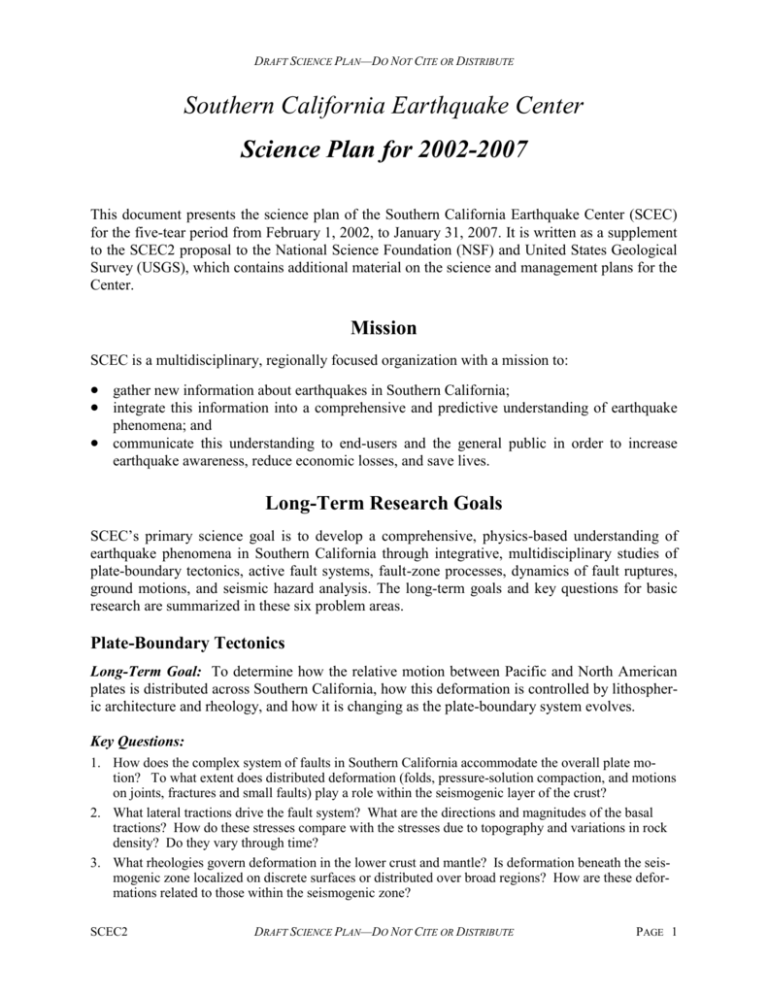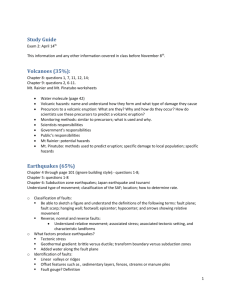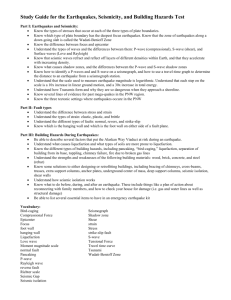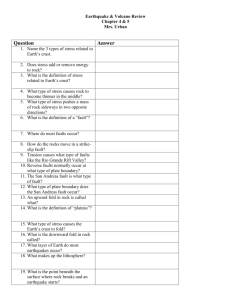Science Plan - Southern California Earthquake Center
advertisement

DRAFT SCIENCE PLAN—DO NOT CITE OR DISTRIBUTE Southern California Earthquake Center Science Plan for 2002-2007 This document presents the science plan of the Southern California Earthquake Center (SCEC) for the five-tear period from February 1, 2002, to January 31, 2007. It is written as a supplement to the SCEC2 proposal to the National Science Foundation (NSF) and United States Geological Survey (USGS), which contains additional material on the science and management plans for the Center. Mission SCEC is a multidisciplinary, regionally focused organization with a mission to: gather new information about earthquakes in Southern California; integrate this information into a comprehensive and predictive understanding of earthquake phenomena; and communicate this understanding to end-users and the general public in order to increase earthquake awareness, reduce economic losses, and save lives. Long-Term Research Goals SCEC’s primary science goal is to develop a comprehensive, physics-based understanding of earthquake phenomena in Southern California through integrative, multidisciplinary studies of plate-boundary tectonics, active fault systems, fault-zone processes, dynamics of fault ruptures, ground motions, and seismic hazard analysis. The long-term goals and key questions for basic research are summarized in these six problem areas. Plate-Boundary Tectonics Long-Term Goal: To determine how the relative motion between Pacific and North American plates is distributed across Southern California, how this deformation is controlled by lithospheric architecture and rheology, and how it is changing as the plate-boundary system evolves. Key Questions: 1. How does the complex system of faults in Southern California accommodate the overall plate motion? To what extent does distributed deformation (folds, pressure-solution compaction, and motions on joints, fractures and small faults) play a role within the seismogenic layer of the crust? 2. What lateral tractions drive the fault system? What are the directions and magnitudes of the basal tractions? How do these stresses compare with the stresses due to topography and variations in rock density? Do they vary through time? 3. What rheologies govern deformation in the lower crust and mantle? Is deformation beneath the seismogenic zone localized on discrete surfaces or distributed over broad regions? How are these deformations related to those within the seismogenic zone? SCEC2 DRAFT SCIENCE PLAN—DO NOT CITE OR DISTRIBUTE PAGE 1 DRAFT SCIENCE PLAN—DO NOT CITE OR DISTRIBUTE 4. What is the deep structure of fault zones? Are major strike-slip faults such as the SAF truncated by décollements or do they continue through the crust? Do they offset the Moho? Are active thrust faults best described by thick-skin or thin-skin geometries? 5. How is the fault system in Southern California evolving over geologic time, what factors are controlling the evolution, and what influence do these changes have on the patterns of seismicity? Fault Systems Long-Term Goal: To understand the kinematics and dynamics of the plate-boundary fault system on interseismic time scales, and to apply this understanding in constructing probabilities of earthquake occurrence in Southern California, including time-dependent earthquake forecasting. Key Questions: 1. What are the limits of earthquake predictability, and how are they set by fault-system dynamics? 2. How does inelastic deformation accumulated over repeated earthquake cycles give rise to landforms and geologic structures? How can this type of geomorphic and geologic information be used to constrain recent deformation rates and structural geometries? 3. Are there patterns in the regional seismicity related to the past or future occurrence of large earthquakes? For example, are major ruptures on the SAF preceded by enhanced activity on secondary faults, temporal changes in b-values, or local quiescence? Can the seismicity cycles associated with large earthquakes be described in terms of repeated approaches to, and retreats from, a regional “critical point” of the fault system? 4. What are the statistics that describe seismic clustering in time and space, and what underlying dynamics—e.g., mode-switching—control this episodic behavior? Is clustering observed in some fault systems due to repeated ruptures on an individual fault segment, or to rupture overlap from multiple segments? Is clustering on an individual fault related to regional clustering encompassing many faults? 5. What systematic differences in fault strength and behavior are attributable to the age and maturity of the fault zone, lithology of the wall rock, sense of slip, heat flow, and variation of physical properties with depth? Is the mature SAF a weak fault? If so, why? 6. To what extent do fault-zone complexities, such as bends, changes in strength, and other “quenched heterogeneities” control seismicity? How applicable are the “characteristic-earthquake” and “slippatch” models in describing the frequency of large events? How important are dynamic cascades in determining this frequency? Do these cascades depend on the state of stress, as well as the configuration of fault segments? 7. How does the fault system respond to the abrupt stress changes caused by earthquakes? To what extent do the stress changes from a large earthquake advance or retard large earthquakes on adjacent faults? How does stress transfer vary with time? 8. What controls the amplitude and time constants of the post-seismic response, including aftershock sequences and transient aseismic deformations? In particular, how important are induction of selfdriven accelerating creep , fault-healing effects, poroelastic effects, and coupling of the seismogenic layer to viscoelastic flow at depth? Fault-Zone Processes Long-Term Goal: To understand the internal structure of fault zones and the microscale processes that determine their rheologies in order to formulate more realistic macroscopic representations of fault-strength variations and the dynamic response of fault segments and fault networks. SCEC2 DRAFT SCIENCE PLAN—DO NOT CITE OR DISTRIBUTE PAGE 2 DRAFT SCIENCE PLAN—DO NOT CITE OR DISTRIBUTE Key Questions: 1. Which small-scale processes—pore-water pressurization and flow, thermal effects, geochemical alteration of minerals, solution transport effects, contact creep, microcracking and rock damage, gouge comminution and wear—are important in describing the earthquake cycle of nucleation, dynamic rupture, and post-seismic healing? 2. What fault-zone properties determine velocity-weakening vs. velocity-strengthening behavior? How do these properties vary with temperature, pressure, and composition? 3. How does fault strength drop as slip increases immediately prior to and just after the initiation of dynamic fault rupture? Are dilatancy and fluid-flow effects important during nucleation? 4. What is the nature of near-fault damage and how can its effect on fault-zone rheology be parameterized? Can damage during large earthquake ruptures explain the discrepancy between the small values of the critical slip distance found in the laboratory (< 100 microns) and the large values (> 100 millimeters) inferred from the fracture energies of large earthquakes? 5. How does fault-zone rheology depend on microscale roughness, mesoscale offsets and bends, variations in the thickness and rheology of the gouge zone, and variations in porosity and fluid pressures? Can the effects of these or other physical heterogeneities on fault friction be parameterized in phenomenological laws based on rate and state variables? 6. How does fault friction vary as the slip velocities increase to values as large as 1 m/s? How much is frictional weakening enhanced during high-speed slip by thermal softening at asperity contacts and by local melting? 7. How do faults heal? Is the dependence of large-scale fault healing on time logarithmic, as observed in the laboratory? What small-scale processes govern the healing rate, and how do they depend on temperature, stress, mineralogy, and pore-fluid chemistry? Rupture Dynamics Long-Term Goal: To understand the physics of rupture nucleation, propagation, and arrest in realistic fault systems, and the generation of strong ground motions by earthquakes. Key Questions: 1. What is the magnitude of the stress needed to initiate fault rupture? Are crustal faults “brittle” in the sense that ruptures require high stress concentrations to nucleate, but, once started, large ruptures reduce the stress to low residual levels? 2. How do earthquakes nucleate? What is the role of foreshocks in this process? What features characterize the early post-instability phase? 3. How can data on fault friction from laboratory experiments be reconciled with the earthquake energy budget observed from seismic radiation and near-fault heat flow? What is explanation of short apparent slip duration? 4. How much inelastic work is done outside a highly localized fault-zone core during rupture? Is the porosity of the fault zone increased by rock damage due to the passage of the rupture-tip stress concentration? What is the role of aqueous fluids in dynamic weakening and slip stabilization? 5. Do minor faults bordering a main fault become involved in producing unsteady rupture propagation and, potentially, in arresting the rupture? Is rupture branching an important process in controlling earthquake size and dynamic complexity? 6. Are strong, local variations in normal stress generated by rapid sliding on nonplanar surfaces or material contrasts across these surfaces? If so, how do they affect the energy balance during rupture? SCEC2 DRAFT SCIENCE PLAN—DO NOT CITE OR DISTRIBUTE PAGE 3 DRAFT SCIENCE PLAN—DO NOT CITE OR DISTRIBUTE 7. What produces the slip heterogeneity observed in the analysis of near-field strong motion data? Does it arise from variations in mechanical properties (quenched heterogeneity) or stress fluctuations left in the wake of prior events (dynamic heterogeneity)? 8. Under what conditions will ruptures jump damaged zones between major fault strands? Why do many ruptures terminate at releasing step-overs? How does the current state of stress along a fault segment affect the likelihood of ruptures cascading from one segment to the next? 9. What are physical mechanisms for the near-field and far-field dynamical triggering of seismicity by large earthquakes? Wave Propagation Long-Term Goal: To determine the structure of urbanized Southern California well enough to predict deterministically the surface motions from a specified seismic source at all frequencies up to at least 1 Hz, and to formulate useful, consistent, stochastic representations of surface motions up to at least 10 Hz. Key Questions: 1. How are the major variations in seismic wave speeds in Southern California related to geologic structures? How are these structures best parameterized for the purposes of wavefield modeling? 2. What are the contrasts in shear-wave speed across major faults in Southern California? Are the implied variations in shear modulus significant for dynamic rupture modeling? Do these contrasts extend into the lower crust and upper mantle? 3. How are variations in the attenuation parameters related to wave-speed heterogeneities? Is there a significant dependence of the attenuation parameters on crustal composition or on frequency? How much of the apparent attenuation is due to scattering? 4. What are the differences in near-fault ground motions from reverse, strike-slip, and normal faulting? In thrust faulting, how does energy trapped between the fault plane and free surface of the hangingwall block amplify strong ground motions? 5. How does the structure of sedimentary basins affect the amplitude and duration of ground shaking? How much of the amplification pattern in a basin is dependent on the location of the earthquake source? Can the structure of sedimentary basins be determined in sufficient detail to usefully predict the pattern of ground shaking for future large earthquakes? 6. Are fault-parallel, low-velocity waveguides deep-seated features of faults? How continuous are they along strike and dip? Can studies of fault-zone trapped waves constrain the effective rheological parameters of the fault zone, such as effective fracture energy? 7. Is the ability to model recorded seismograms limited mainly by heterogeneity in source excitation, focusing by geologic structure, or wavefield scattering? 8. What role do small-scale heterogeneities and irregular interfaces play in wave propagation at high frequencies? How do they depend on depth, geological formation, and tectonic structure? How important is multiple scattering in the low-velocity, uppermost layers? Can stochastic parameterizations be used to improve wavefield predictions? Seismic Hazard Analysis Long-Term Goals: To incorporate time dependence into the framework of seismic hazard analysis in two ways: (a) through the use of rupture dynamics and wave propagation in realistic geological structures, to predict ground motions for anticipated earthquakes, and (b) through the use SCEC2 DRAFT SCIENCE PLAN—DO NOT CITE OR DISTRIBUTE PAGE 4 DRAFT SCIENCE PLAN—DO NOT CITE OR DISTRIBUTE of fault-system analysis, to forecast the time-dependent perturbations to average earthquake probabilities in Southern California. Key Questions: 1. What factors limit fault-rupture propagation? How valid are the cascade and characteristicearthquake models? What magnitude distribution is appropriate for Southern California? 2. How can geodetic (GPS and InSAR) measurements of deformation be used to constrain short- and long-term seismicity rates for use in seismic hazard assessment? How can geologic and paleoseismic data on faults be used to determine earthquake recurrence rates? 3. What temporal models and distributions of recurrence intervals pertain to faults in Southern California? Under what circumstances are large events Poissonian in time? Can PSHA be improved by incorporating non-Poissonian distributions? 4. Can physics-based scenario simulations produce more accurate estimates of ground-motion parameters than standard attenuation relationships? Can these simulations be used to reduce the high residual variance in these relationships ? 5. What is the nature of near-fault ground motion? How do fault ruptures generate long-period directivity pulses? How do near-fault effects differ between reverse and strike-slip faulting? Can these effects be predicted? 6. What are the earthquake source and strong ground motion characteristics of large earthquakes (magnitudes larger then 7.5), for which there are few strong motion recordings? Can the shaking from large earthquakes be inferred from smaller events? 7. How does the nonlinear seismic response of soils depend on medium properties, amplitude, and frequency? SCEC2 DRAFT SCIENCE PLAN—DO NOT CITE OR DISTRIBUTE PAGE 5 DRAFT SCIENCE PLAN—DO NOT CITE OR DISTRIBUTE Short-Term Research Objectives Short-term objectives are priorities for immediate research. All carry the expectation of substantial (and measurable) success during the first year, either in progress toward a specific short-term objective or in building (or maintaining) a sustained effort to reach a long-term goal. These priorities will be reflected in the SCEC Request for Proposals, to be issued in mid-October, and they will set the programmatic milestones for the Center’s internal assessments. Disciplinary Activities SCEC2 will sustain disciplinary science through standing committees in seismology, geodesy, geology, and rock mechanics. These committees will be responsible for planning and coordinating disciplinary activities relevant to SCEC2 objectives, and will make periodic recommendations to the Planning Committee regarding the support of disciplinary infrastructure. Highpriority disciplinary activities include the following tasks: A. Seismology 1. Data gathering: improve the distribution of regional seismic data, including strong-motion data, in coordination with the California Integrated Seismic Network (CISN), the Advanced National Seismic System (ANSS), COSMOS, the IRIS Data Management Center (IRIS DMC), and other organizations; plan SCEC2 seismic experiments in coordination with EarthScope and other programs 2. Data products: improve earthquake catalogs (locations, sizes, and mechanisms), structural models, and capabilities for visualizing earthquake information; improve methods for assimilating broadband seismic data into 3D structural models. 3. Post-earthquake response: foster capabilities for post-earthquake deployments of portable broadband instruments in coordination with IRIS, EERI, and other organizations. B. Tectonic Geodesy 1. Data gathering: operate the Southern California Integrated GPS Network (SCIGN) in partnership with JPL/NASA; improve the distribution of data from SCIGN, survey-mode GPS deployments, and InSAR systems in coordination with UNAVCO, EarthScope, and the California Spatial Reference Center; coordinate plans for SCEC2 survey-mode GPS experiments with these organizations. 2. Data products: release version 3.0 of the Crustal Motion Model (CMM); produce surfacestrain maps and fault-slip models from the CMM; produce time-dependent deformation fields for use in stress-transfer investigations; incorporate InSAR imaging of tectonic deformations into the CMM. 3. Post-earthquake response: foster capabilities for InSAR imaging of co- and post-seismic deformations and for post-earthquake deployments of portable GPS instruments in coordination with UNAVCO, NASA, and other organizations. SCEC2 DRAFT SCIENCE PLAN—DO NOT CITE OR DISTRIBUTE PAGE 6 DRAFT SCIENCE PLAN—DO NOT CITE OR DISTRIBUTE D. Earthquake Geology 1. Data gathering: plan, coordinate, and provide infrastructure for geologic fieldwork; formulate field tests of paleoseismic methodology; develop databases comprising high-resolution topography, slip rates of active faults, paleoseismic chronologies, paleo-indicators of strong ground motions, and other geologic measurements of active tectonics; foster subsurface analysis of fault systems, including blind thrusts. 2. Data products: integrate field and laboratory efforts to date geologic samples and events, including standardized procedures for field documentation, sample treatment, dating methodologies, and data archiving and distribution; produce long-term rupture histories for selected strike-slip systems in Southern California. 3. Post-earthquake response: foster capabilities for post-earthquake field studies in coordination with EERI and other organizations. E. Rock Mechanics 1. Data gathering: foster scientific interactions between SCEC investigator groups and laboratories with active research programs in rock-deformation mechanics; plan fieldwork on exhumed fault zones to determine the relationship between fault structure and fault mechanics, with special emphasis on determining the width of the primary sliding zone. 2. Data products: assess information and products from rock-mechanics experiments and fieldwork that will be most useful in SCEC2 studies of earthquake physics and fault-system dynamics. Interdisciplinary Focus Areas SCEC2 interdisciplinary research will be organized into five focus areas: (1) unified structural representation, (2) fault systems, (3) earthquake physics, (4) ground motion, and (5) seismic hazard analysis. In addition, the SCEC2 framework will incorporate a sixth area, risk assessment and mitigation, that will be the subject for collaborative activities between SCEC scientists and partners from other communities—earthquake engineering, risk analysis, and emergency management. This partnership will be managed through an implementation interface, designed to foster two-way communication and knowledge transfer between the different communities. SCEC2 will also sponsor a partnership in information technology, with the goal of developing an advanced IT infrastructure for system-level earthquake science in Southern California. Highpriority activities are listed for each of these interdisciplinary focus areas: F. Structural Representation 1. Community velocity model (CVM): improve databases and data assimilation techniques for refining the CVM; extend parameterization to include anelastic dissipation and topography; assess consistency of derived parameters (e.g. density) with available data (e.g., gravity); extend to offshore region. 2. Community fault model (CFM): coordinate the compilation of fault databases in Southern California; produce a coarse-resolution CFM of the entire region; develop high-resolution CFMs for selected areas; provide dynamic linkages between fault databases and fault models. SCEC2 DRAFT SCIENCE PLAN—DO NOT CITE OR DISTRIBUTE PAGE 7 DRAFT SCIENCE PLAN—DO NOT CITE OR DISTRIBUTE 3. Unified structural representation (USR): develop specifications for a unified, object-oriented representation of active faults and 3D earth structure for use in fault-system analysis and ground-motion prediction; begin integration of CVM and CFM into the USR; identify and prioritize data-gathering efforts to improve the USR. G. Fault Systems 1. Fault-system behavior: quantify the space-time behavior of Southern California seismicity using paleoseismology, tectonic geomorphology, historical records, and instrumental catalogs; compare short-term geodetic rates with long-term geologic rates and explain the differences; investigate the effects of afterslip, viscoelasticity, and poroelasticity on long-term stress transfer between faults following moderate to large earthquakes. 2. Deformation models: develop and validate 3D quasi-static, finite-element codes for simulating block motions and deformations in coordination with GEM, GeoFEM, ACES, and other modeling efforts; develop deformation models of Southern California consistent with observed topography, fault geometries and properties, geologic slip rates, geodetic motions, and earthquake histories; use these models to infer fault slip, rheologic stratification, and fault interactions through stress transfer. 3. Earthquake simulators: develop and validate codes for simulating earthquake catalogs in coordination with GEM, GeoFEM, ACES, and other modeling efforts; assess the utility of these models in forecasting Southern California earthquakes and in testing empirical forecasting schemes. 4. Offshore fault systems: plan strategies for interdisciplinary investigations of the fault systems offshore Southern California in coordination with the USGS marine program, the NSF MARGINS program, and other oceanographic activities. H. Earthquake Physics 1. Reference earthquakes: establish a set of reference events with documentation that includes databases of seismic, geodetic, and geologic observations as well as models of fault geometries, near-source structures, deformation histories, and stress changes. 2. Fault-zone structure: investigate the 3D structure of fault zones, including step-overs, transfer zones, branching points, and how this structure is coupled to stress heterogeneity and earthquake complexity; apply high-resolution location techniques to resolve the fine structure of microseismicity on active faults in Southern California, and compare with similar studies of other faults. 3. Source models: develop and validate numerical algorithms for simulating earthquake sources, including dynamical models of fault rupture and stochastic models of highfrequency radiation from faults; test source models against data from reference earthquakes. 4. Rupture dynamics: develop techniques for the assimilation of seismic and geodetic data into dynamic rupture models; use dynamical simulations to assess the discrepancies between laboratory-based friction laws that explain some observed fault-system behaviors (e.g., earthquake productivity, post-seismic response) and seismological inferences from large earthquakes (e.g., fracture energies, particle velocities, and accelerations). 5. Earthquake interactions: develop more realistic models for short-term stress transfer, including rate- and state-dependent friction, dynamic triggering, and fault-zone damage/healing SCEC2 DRAFT SCIENCE PLAN—DO NOT CITE OR DISTRIBUTE PAGE 8 DRAFT SCIENCE PLAN—DO NOT CITE OR DISTRIBUTE mechanisms; test stress-transfer models and earthquake probability estimates derived from them. I. Ground Motions 1. Deterministic wavefield models: develop anelastic wave-propagation codes and nonlinear site-response codes; validate these codes by intercomparisons of computed wavefields, including those for reference earthquakes. 2. CVM improvement: use data from reference events to assess, as a function of frequency, wavefield simulations based on the CVM; compare with results from other structural representations (including 1D and 2D representations); plan strategy for improving the accuracy and frequency range of deterministic wavefield modeling, including the assimilation of seismographic data into the CVM. 3. Stochastic wavefield models: develop stochastic models of high-frequency radiation that can be combined with deterministic models of low-frequency radiation to predict strong ground motions; validate the models by intercomparisons and testing with observed data. 4. Earthquake scenarios: simulate ground motions for probable earthquake scenarios by combining source, wave-propagation, and site-response models. J. Seismic Hazard Analysis 1. Urban hazards: resolve strain-history discrepancies in the Los Angeles region; explore hazard implications of alternative fault geometries. 2. Attenuation relationships: improve on the Phase-III study by incorporating source directivity, nonlinear soil amplification, and near-fault effects. 3. Regional earthquake likelihood models (RELM): coordinate with other focus groups new releases of the key infrastructure elements, including earthquake catalogs, fault-activity database, CFM, and CMM; develop prototype versions of earthquake-forecasting models based on different assumptions and information types; identify geophysical data to be used in the testing of the models. 4. Probabilistic seismic hazard analysis (PSHA): develop and verify web-accessible, objectoriented PSHA codes; incorporate new data and models from the Phase-III and RELM efforts; provide input to seismic hazard mapping efforts by the USGS and CDMG. 5. Intensity measures: in collaboration with earthquake engineers, develop new measures of ground-motion behavior that can be used in probabilistic seismic performance analysis, including vector-valued measures and their correlations. K. Implementation Interface 1. Earthquake engineering centers: develop collaborations in one or more research areas, such as near-fault seismic risk, use of earthquake simulations in risk assessment, PEER’s Program of Applied Earthquake Engineering for Lifeline Systems, and the hospital retrofit problem. 2. Network for Earthquake Engineering Simulation (NEES): develop collaborations with CUREE and other organizations to provide seismic hazard information, particularly groundmotion time histories, as input into NEES testing facilities and simulations. 3. HAZUS loss-estimation methodology: assist FEMA in the development of the Southern California HAZUS User’s Group; provide seismic hazard inputs for HAZUS-based calculations in Southern California. SCEC2 DRAFT SCIENCE PLAN—DO NOT CITE OR DISTRIBUTE PAGE 9 DRAFT SCIENCE PLAN—DO NOT CITE OR DISTRIBUTE L. Information Technology 1. Data structures: define the data structures needed to exchange information and computational results in SCEC research; implement these data structures via XML schema for selected computational pathways in seismic hazard analysis and ground-motion simulation. 2. Community models: develop, verify, benchmark, document, and maintain SCEC community models. 3. Visualization tools: develop tools for visualizing earthquake information that improve the community’s capabilities in research and education. 4. Digital libraries: organize collections for and contribute IT capabilities to the Electronic Encyclopedia of Earthquakes (E3). SCEC2 DRAFT SCIENCE PLAN—DO NOT CITE OR DISTRIBUTE PAGE 10









